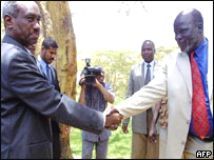Sudanese VP, southern rebel leader to meet Dec. 11 : Mediator
NAIROBI, Nov 1, 2004 (AP) — Sudanese Vice President Ali Osman Taha will meet southern rebel leader John Garang next month to work out final details of how to implement a comprehensive deal to end a 21-year civil war in the country, the chief mediator said Monday.
 At the talks Dec. 11, the two leaders will also seek to resolve differences over a rebel demand that the Sudanese government fund a separate army that insurgents would maintain under their own command in the South as a security guarantee, chief mediator Gen. Lazaro Sumbeiywo said.
At the talks Dec. 11, the two leaders will also seek to resolve differences over a rebel demand that the Sudanese government fund a separate army that insurgents would maintain under their own command in the South as a security guarantee, chief mediator Gen. Lazaro Sumbeiywo said.
More than 2 million people have died in the southern conflict, which is separate from fighting in the western region of Darfur, where pro-government Arab militias are accused of waging a campaign of murder, rape and arson on African villagers.
Sudanese government and rebel negotiators Friday adjourned talks to end the fighting in southern Sudan after narrowing differences on how they would implement a comprehensive peace deal, mediators said Monday.
During two weeks of negotiations, government and rebel experts discussed “the timing of events, the executing bodies to be established, their composition, the funding sources and the procedures or processes to be followed” while implementing the peace deal, mediators said.
“However, there is quite some ground to be covered,” Sumbeiywo said, adding experts will resume talks on Nov. 26 to further bridge the gap in time for the meeting of their chief negotiators – the Sudanese vice president and the southern rebel leader.
“Those talks will…thrash out the final details of the implementation program,” Sumbeiywo told The Associated Press.
The southern peace talks resumed Oct. 7. The government and rebels have agreed to form a 24,000-member national army, with half the troops from each side. But they are at odds over a rebel demand to maintain a separate army as a security guarantee during a six-year transition period.
They also disagree on how and when to disarm other armed groups in southern Sudan and how to incorporate members into rebel and government forces.
The conflict broke out in 1983 after the rebels from the mainly animist and Christian south took up arms against the predominantly Arab and Muslim north. Most of the 2 million casualties have come from war-induced famine.
Although often simplified as a religious war, the conflict is fueled by historical disputes and competition for resources, including major oil reserves.
